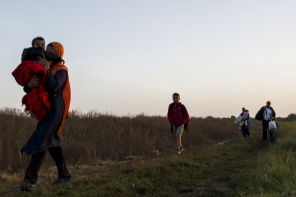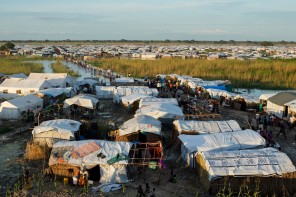The United Nations is starting to rethink that question. The UN Development Program yesterday unveiles this year’s Human Development Report and the Human Development Index (HDI), the annual statistical extravaganza that offers an alternative to GDP as a measure of well-being.
This year, the HDI does something new for the poor: It multiplies them.
The report introduces a new measure for poverty. Called the “multidimensional poverty index” (MPI), it’s a different way of thinking about who is or isn’t poor. The old way was (comparatively) easy: Count the number of people who live on less than $1.25 a day. The report still does that, but it augments that income standard with a, well, multidimensional index.
Okay, first the wonky stuff. Stick with me here: With household survey data from 104 countries, researchers figured out how many households in a given country are “deprived” of any of 10 indicators of health, education and basic living standards. If a household is missing 3 or more of the 10 indicators, it’s categorized as poor.
So what does that mean? It means that Rwanda, for example, may be poorer than those income numbers make it look: 60 percent of Rwandans live below the poverty line the country establishes for itself, but UNDP says that more than 80 percent of Rwandans are “multi-dimensionally poor.”
“People’s lives cannot be measured simply in terms of money or income,” says Jeni Klugman, director and lead author of the Human Development Report. “There’s much broader dimensions which people value and have reason to value.”
The MPI does something else: It measures the intensity of that multi-dimensional poverty. That can tell you not only what percentage of a population are poor, but just how poor they are. (Is it me, or is there something almost Tolstoyian about it?)
There’s a lot more to say about this year’s report; it also introduces two other new indices, and it’s got a lot of pages. Watch this space for my more in-depth treatment, including the questions this raises about aid.



As usual the UN calculates and re-calculates and talks and does nothing really.
Really enjoy your blog.
Have you seen Duncan Green’s hosting of a UNDP-World Bank (Gozilla vs. King Kong, some have said) debate on the MPI, http://www.oxfamblogs.org/fp2p/?p=3061 ? My take is that MPI itself won’t shift much aid philosophy — but the renewed look at inequality-adjusted HDI (one of the other new indices) can do a bit more. (Can also see Duncan’s Thursday posting on IMF’s going all-out socialist on equity issues, in fact.)
BBC yesterday did a piece on how the overall HDI trends the report highlights shows that ‘aid works’ — which I found a bit odd. The HDR 2010 doesn’t explicitly make that pitch, but more takes the position that investing in health and education does wonders, whereas economic growth doesn’t always have a clear relation. The added touch in the HDR that I found interesting was a bit of that concern about context and politics in a specific setting. So where aid ‘works,’ it’s to do with how it’s spent and political context as much as quantity.
I used to work in the Global HDR Office and could perhaps put you in touch with some folk there if useful.
Thanks for the oxfam blog link; fascinating. The inequality-adjusted HDI is a disaster of a measure to understand for anyone who’s not a statistician; Klugman explained it well to me, but I’m going to have a bitch of a time explaining it in my article. How do you foresee that one shifting aid?
BBC’s take is interesting. And odd. I didn’t get that pitch, either, from the report’s author, and I also find the conclusion strange generally. In fact, the MPI suggests to me the opposite in many places — all that aid, and we can still see how poor people are in many of the same areas that aid delivery is happening… Your point on the politics/context though is well taken, glad you reiterated.
Thanks for the offer to connect me to the HDR folks; I think I have most what I need from there in my interview with Klugman, but I appreciate it!
Having moved from the Global HDR to national reports (I’m currently drafting the 1st Sudan HDR), the HDI increasingly looks like a clumsy indicator, mostly helpful to gauge national-level, average trends. This, I think, makes it useful primarily for NY-DC-London-based aid agencies on deciding overall aid allocations looking out at a big, bad world needing prioritization.
The inequality-adjusted index takes that peak under the cover of the national level aggregates to say which areas of human development (education, say) in that country are falling behind, and so where national policy can be met with international aid. This has potential to raise equity in development across populations on the agenda, and help make priorities in specific sectors.
Sudan’s case, for instance, looks largely like a miracle, kinda like the DRC trends the Human Security Report you reviewed earlier this year argues for, where mom and children health improve despite violence. Taking that national trend apart to say, hey, not everybody is doing equally well tells a much more realistic story.
But that complexity in understanding the inequality-adjusted HDI you highlight is a huge factor — that right there may make it a moot point, really. The normal, unadjusted HDI is so appealing because of its intuitive, just-makes-sense function.
(And sorry, hadn’t realized Klugman’s quote was from your interview; thought it was from the media materials they put out!)
Your Sudan example is really, really interesting. I can see the potential of the inequality-adjusted index — are there other people shorthanding it iHDI? Because that’s what happened as I was typing my interview notes, and it’s super handy 🙂 — but it’s mind-boggling to lay folks. On the other hand that’s okay; if it’s a tool specialists know how to use, and it makes a difference to specialists, it may not matter if the rest of us get it. What might matter is if there’s a divergence between how specialists with special tools and generalists who don’t know or understand those tools see a problem — a data guy like you, say, and a journalist like me. If I read the HDR and I get the HDI, but you’re working your magic toward targets set with the iHDI in mind, I’m gonna miss the boat in trying to understand what you’re doing. Substitute out journalist and insert, god forbid, Congressional aides or something… But I don’t know how big a risk that really is. What do you think?
(No worries, I am always happy to have people offer sources, and would have jumped on that chance if I hadn’t had good luck in phone calls yesterday — thanks!)
Yeah, I think pretty much the complexity in explaining IHDI (I think that’s the running preferred acronym) makes the index near-obsolete for policy-making at country-level from the get go. HDI works for two main reasons: it’s casually intuitive — Does development mean more than income? Why, yes, yes it does… — and because an (eventual) Nobel laureate designed it, Amartya Sen. This logic and authority don’t stand behind the IHDI.
But I’m curious: you mention Congressional aides as perhaps the ones who need to understand this. Not so sure American policymakers are the heart of concern on this. What vexes me, is, How do I explain this to my counterparts in the Ministry of Social Security and Welfare? Or to students at Khartoum University (who are nowadays trained in Arabic)?
Does a human development or multidimensional poverty lens help to provide insightful analysis into the penury of much of the Sudanese condition? Does it help think through the question, for instance, of, How should South Sudan best establish a firm public administration in the coming years, if the referendum goes the way that’s likely?
I think the answer is yes, with a condition: If the conceptual analysis is contextualized properly. With IHDI, I do worry to some degree the global human development debate is charging forcefully ahead, leaving behind whole pockets of countries where basic ideas and policies are still struggling to take root. Where the eureka moment of, ‘Right, development surely means more than income…’ is far from the policy agenda still.